Why You Need to Have an Email Newsletter
 Here’s what happened when the email newsletter of freelancer Genevieve J. Walker, PhD, PC arrived in my inbox. Seeing that email reminded me that Genevieve is my go-to freelancer. When I need to sub-contract freelance work or have a freelance job to refer to another freelancer, Genevieve is at the top of my list. And reading Genevieve’s email newsletter reinforced her expertise as an expert in health literacy and readability.
Here’s what happened when the email newsletter of freelancer Genevieve J. Walker, PhD, PC arrived in my inbox. Seeing that email reminded me that Genevieve is my go-to freelancer. When I need to sub-contract freelance work or have a freelance job to refer to another freelancer, Genevieve is at the top of my list. And reading Genevieve’s email newsletter reinforced her expertise as an expert in health literacy and readability.
Genevieve’s email newsletter, The Health Writer, put her at the top of my mind.
Being first in line for freelance work—or having top-of-mind awareness—is important. Clients and other freelancers remember the freelancer who’s been in touch most recently and most often.
An email newsletter is an easy way to be first in line when a client is ready to hire a freelancer or a colleague has a freelance job to refer to another freelancer. Email newsletters are also called e-newsletters.
How Genevieve’s Email Newsletter Helps Her Freelance Business
“I seem to get a new assignment or two every time I send out a newsletter issue,” says Genevieve. “I think The Health Writer jogs my clients’ memories about meaning to contact me, or reminds them of something I do that they haven’t done for a while.”
Genevieve started The Health Writer in 2013. Here’s what it looks like.
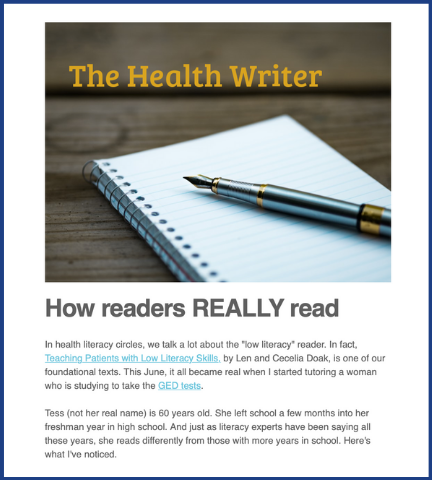
Click here to see the full issue online.
How My Email Newsletter Helps My Freelance Business
My email newsletter, Engage!, has helped me get more freelance work too. In 2017, I got a freelance job that was so big that I had to bring in three other freelancers to work with me. One of those freelancers was Genevieve. In 2019, I got another big freelance job from the same client.
Also, about a week after I sent my Fall 2019 email newsletter, a client I hadn’t worked with for a while hired me again.
Other clients have hired me, and freelance friends have referred freelance work to me, shortly after I sent out my email newsletter. Sometimes these are new clients who had expressed interest in my services but hadn’t hired me yet. And sometimes they’re clients who I hadn’t worked with for a while.
Now it’s time for my confession. When I saw Genevieve’s email newsletter, it reminded me that my email newsletter had been sitting on my desk for months. I had started it, but never finished it. Within three days of getting Genevieve’s email newsletter, I had finished mine and sent it out.
I started Engage! in 2014. Here’s what it looks like.
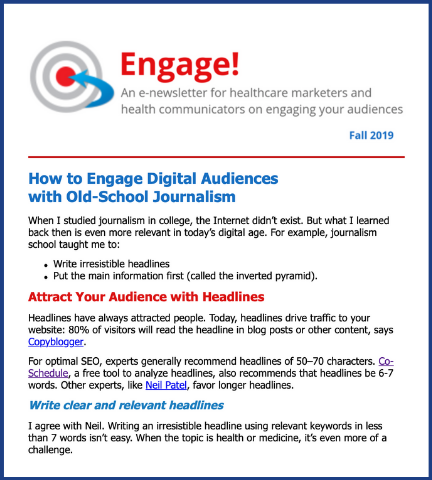
Click here to see the full issue online.
Why Email Newsletters Work for Freelancers
Clients want to work with freelancers they know and trust—or freelancers recommended by someone they know and trust. And other freelancers only refer freelance work to colleagues they know and trust. An email newsletter helps you build trust and show your expertise.
Marketing coach Michael Katz says that an email newsletter makes you “a likeable expert.”
Also, it’s easy to stay in touch with everyone on your follow up list—current clients, inactive clients, interested clients, and freelance and other colleagues—with an email newsletter. Inactive clients are clients you’re on good terms with but haven’t worked with for a while. Interested clients is my term for clients who’ve said they are interested in your freelance services but haven’t hired you yet.
Up to 90% of the time, clients don’t need freelance help when you first meet or market to them. But many of them will need a freelancer within 12 months or so. Your email newsletter can help ensure that you’re first in line when that time comes.
Because so few freelancers have email newsletters, if you create one, you’ll stand out!
Who to Send Your Email Newsletter to and When
Genevieve publishes The Health Writer about three times a year. Her email lists includes 100+ clients (current, past, and prospective) and colleagues. “Don’t produce it too often,” says Genevieve. “I’ve actually received positive comments because mine doesn’t arrive very frequently.”
I usually publish Engage! twice a year. My Fall 2019 issue went to just 36 people: current, inactive, and interested clients, and freelance friends liked Genevieve.
Both Genevieve and I have mature freelance businesses. If you’re actively building your business, I recommend publishing your email newsletter quarterly.
Slash Promotional Email Newsletter Content
“Get rid of the self-promotion (most of the time) and focus on sending your subscribers educational, relevant, timely information,” says Ginny Mineo in a blog post on email newsletters for HubSpot. Mineo says your content should be “90% educational and 10% promotional.”
Too many email newsletters focus on the freelancer. That won’t help you get more freelance work.
As Bill Widmer says in How to Write A Newsletter: Step-By-Step Guide (With Real Examples), “Your audience doesn’t care about your life or your problems. They only care about how you can help THEM with THEIR life and problems.”
Focus Email Newsletter Content on Your Audience
Focus on content that’s useful to clients and colleagues, like Genevieve and I do. We show our expertise and how we can help our clients without “selling” our services.
Providing audience-focused content makes an email newsletter a professional, low-pressure freelance marketing tool.
Genevieve’s feature story is usually on writing for patients and the public. “How readers REALLY read,” a story about what low health literacy means for medical writing, was the feature story in the Fall 2019 issue of The Health Writer. Engaging digital audiences was the feature story in my Fall 2019 issue of Engage! Along with showing our expertise, these stories let Genevieve and I highlight freelance work that we like to do and that clients need help with.
Ideas for feature stories usually come from our work. For example, Genevieve’s Fall 2019 feature story was based on her experience tutoring a woman who’s going for her GED. In a past issue, she wrote about using gender-inclusive terms, which came up in her work for a client.
After our feature stories, Genevieve and I each have reviews of interesting books we think our clients and colleagues would like. Only near the end of our email newsletters do we include a little promotional content. And it’s professional and low-key. We both list a few highlights of our recent freelance work and we both have an “about” section.
Here are our “about” sections.
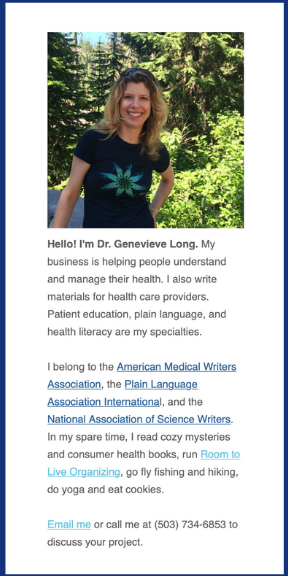
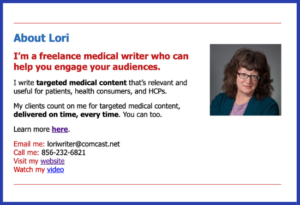
Learn more about email newsletter content
11 Steps to a Remarkable E-Newsletter that Will Impress Clients
Also, we keep our copy and design clear, concise, and scannable. “A newsletter can easily feel cluttered because of its nature,” says Mineo. Looking uncluttered, she says, takes two things: “concise copy and enough white space in the design.”
Use a Professional Email Newsletter Design
Use a professional email newsletter design that’s easy to scan. It’s fairly easy to design a professional email newsletter using a template from services like MailChimp or Constant Contact.
Genevieve uses one of MailChimp’s templates. “I’m usually a fan of hiring a designer, but templates have gotten so good, I’ve enjoyed the chance to save money and time by DIY-ing the newsletter,” she says.
And MailChimp is easy to use. “I’m not very tech-y and don’t want to be. I want to focus on medical writing instead. MailChimp makes everything easy,” says Genevieve. For a freelancer’s email newsletter, the free version of MailChimp works fine.
I started Engage! on Constant Contact. Now I use AWeber, but that’s for the capabilities I need for The Mighty Marketer. If you’re just doing a freelancer’s email newsletter, MailChimp or Constant Contact are easier to use than AWeber.
Both Genevieve and I have experience working on newsletters with clients and employers. So designing our email newsletters may be a little easier for us than it is for you. If you’re more comfortable hiring a designer to create a template for your first issue, then go ahead and do this. After that, you can design each issue on your own.
Boost your messages with images. I use my logo on my email newsletter and usually include a simple chart in my feature story. Genevieve uses a photo with her feature story and several smaller photos with the shorter stories. If you want free images, then try Pixaby. For great fee-based images, search for Essentials (lowest price) images on iStock. We both include a photo of ourselves in our “about” sections.
Maximize Reach with Your Email Newsletter
Reach more potential clients and colleagues by promoting your email newsletter. Include a sample issue and an invitation to subscribe on your website. Genevieve does this at the bottom of her home page.
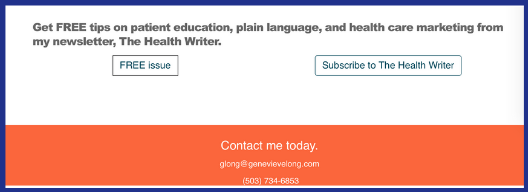
Since the bottom of my home page has a storyteller’s checklist and my video, I didn’t want to add anything else. I put the sample issue at the bottom of my About page and an invitation to subscribe on my Contact page.
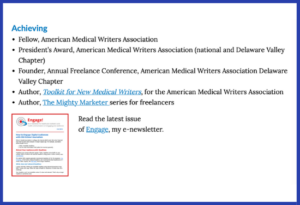
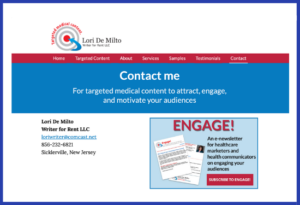
You can also promote each issue and reach more potential clients and colleagues by writing a post on LinkedIn. This is what Genevieve did with her Fall 2019 issue.
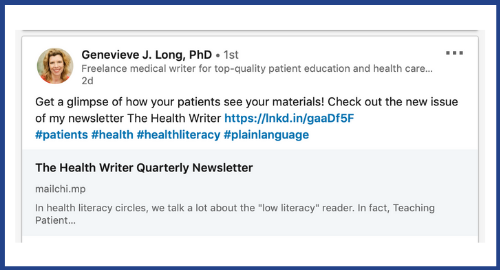
In this post, Genevieve provided useful information to increase her LinkedIn activity. And being more active on LinkedIn helps more clients find you.
Be First in Line for Freelance Work
Don’t miss out on this easy way to create top-of-mind awareness so that clients and colleagues will think of you first for freelance work.
Developing the first issue of your email newsletter takes time. Once you’ve done this, each issue should only take a few hours.
Learn more about how to develop your email newsletter
11 Steps to a Remarkable E-Newsletter that Will Impress Clients
“Even with all our technology and social media, a short newsletter that doesn’t come out too often, and is sent selectively, remains a good tool for reaching people,” says Genevieve. And she enjoys working on The Health Writer. “Choosing photos and deciding what book to review is fun. I don’t have that much creative control in most of my assignments, which is fine. But the newsletter lets me be extra-creative,” she says.
Grow Your Freelance Business
Practical advice and free checklists, templates, and more.
Learn More About Email Newsletters for Freelancers
Content from The Mighty Marketer
11 Steps to a Remarkable E-Newsletter that will Impress Clients
How to be First in Line for Freelance Work
Other Content
Ginny Mineo, How to Create an Email Newsletter People Actually Read
Bill Widmer, How to Write A Newsletter: Step-By-Step Guide (With Real Examples)
Our e-newsletters
Genevieve Long, PhD, The Health Writer
Lori De Milto, Engage!
Email Marketing Services
Images
Pixaby (free images)
iStock (Essentials, lowest price images)